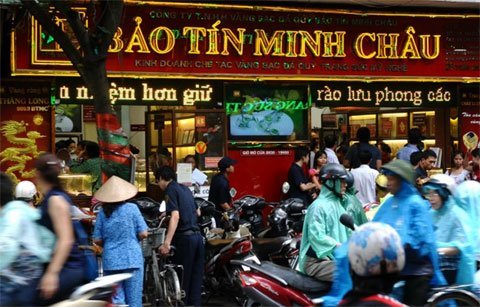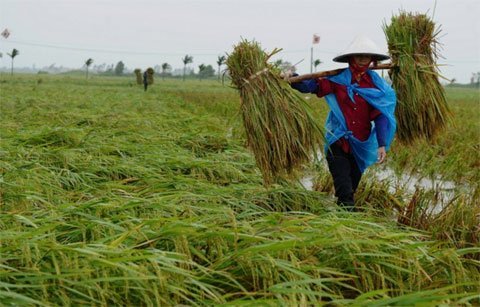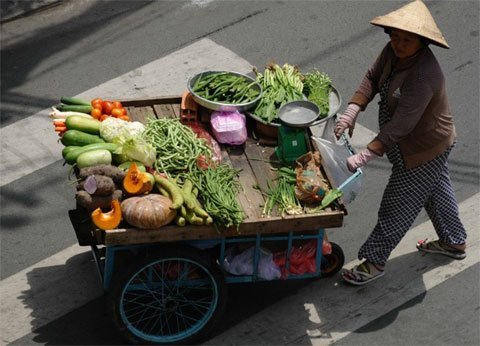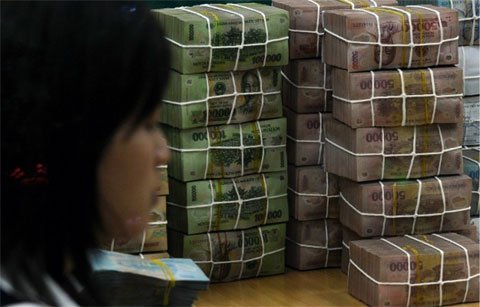LTS bản tin của công ty Mc Kinsey khuyến cáo tập đoàn tư bản đỏ việt gian cs.
McKinsey to Vietnam: Speed up economic reforms, or you’ll get left behind.
McKinsey to Vietnam: Get Cracking
-
- Southeast Asia Real Time provides analysis and insight into the region, which includes Singapore, Thailand, Indonesia, Vietnam, Malaysia, the Philippines, Myanmar, Cambodia, Laos and Brunei. Contact the editors atSEAsia@wsj.com.
By Patrick Barta
http://blogs.wsj.com/searealtime/2012/02/24/mckinsey-to-vietnam-get-cracking/

- Reuters
- A man works at a construction site of a bridge crossing in Hanoi.
[wsj-more=in tag="Vietnam"]
The experts at global consulting firm McKinsey & Company have a message for Vietnam:Speed up economic reforms, or you’ll get left behind.
In a new report issued this week, the firm’s research arm – The McKinsey Global Institute – concluded Vietnam needs to do more to shake up its state-owned enterprises and boost labor productivity, among other steps – challenging tasks that if not executed could saddle Vietnam with sub-par growth for years to come.
According to the report, two main engines have driven Vietnam’s remarkable economic growth of recent years: an expanding labor pool, and a structural shift away from agriculture into more productive sectors such as manufacturing and services. Those factors combined to put more people to work, often in more-advanced jobs than farming, and together accounted for about two-thirds of Vietnam’s gross domestic product growth from 2005 to 2010, it said.
But now those two drivers are expected to fade. As Vietnam’s population ages, the growth in its labor force is likely to slow to around 0.6% a year over the next decade, from annual growth of 2.8% between 2000 and 2010, the report said. Moreover, the country can no longer count on the migration of people from farms to factories to drive productivity gains, since so many people have already completed that transition.
The solution, according to the report, is that Vietnam must find other ways to boost its labor productivity growth — by more than 50%, from 4.1% annually to 6.4% — if the government wants to meet its target of 7% to 8% annual economic growth by 2020. Without such productivity gains, it said, Vietnam’s annual growth will likely wind up closer to 4.5% to 5% — not bad, but below the levels many economists think Vietnam needs to dramatically boost incomes and living standards.
“Deep structural reforms within the Vietnamese economy will be necessary, as well as strong and sustained commitment from policy makers and firms,” to get the kind of productivity growth it needs, the report said.
The needed reforms include steps to encourage more business innovation and bring change to the country’s many state-owned enterprises, which account for 40% of Vietnam’s output but in many cases have a reputation for inefficiency. Although Vietnamese leaders have long talked about prodding state enterprises into becoming more efficient or even privatizing them, the efforts to date have fallen far short of targets suggested by private-sector economists.
Other possible reforms could include steps to promote Vietnam as a global outsourcing hub, upgrade technology in industries such as fish farming, expand telecommunications and electricity infrastructure, improve education to get more skilled workers, and push factories to embrace more value-added manufacturing. At the moment, Vietnam’s exports tend to be relatively “low-value” compared to other Southeast Asian countries and China, the report said.
The McKinsey folks also identified other long-term risks to the Vietnamese economy,including an overall lack of transparency and a rapid expansion of bank lending that leaves the country vulnerable to financial-sector distress. Bank lending expanded 33% a year over the past decade in Vietnam, the highest growth rate in Southeast Asia, the report said. Although reported data indicate non-performing loans are not a serious issue, McKinsey – echoing other experts –said the latest figures likely understate the problem. There’s also a concern that state banks may at times lend based on political grounds instead of financial merit, the report said, further exposing them to losses.
Vietnam policymakers say the McKinsey experts aren’t telling them anything they haven’t heard already.
“I totally agree with what is mentioned in the report,” said Vo Tri Thanh, vice director of the Central Institute for Economic Management, a government think tank. “These are not new discoveries, however. Where Vietnam should start, and how to do it, is still a question.”
----------------
sau đây là bản dịch do bút nô việt gian cs viết sai lạc dể ca tụng tập đoàn việt gian cs bán nước.
Thứ Bẩy, 25/02/2012
Những điểm khiến thế giới sửng sốt về Việt Nam
Trong báo cáo "Duy trì sự phát triển của Việt Nam: Thách thức về năng suất", Viện McKinsey toàn cầu đã đưa ra những điểm mà công chúng thế giới chưa biết về VN.
Rõ ràng là ở Đông Nam Á đã có nhiều thay đổi kể từ chiến tranh Việt Nam. Trong suốt hơn 25 năm qua, Việt Nam đã tự chuyển mình. Năm 2007, Việt Nam trở thành thành viên chính thức của cộng đồng kinh tế toàn cầu thông qua việc là thành viên của Tổ chức thương mại thế giới (WTO).
Việt Nam đã trở thành nam châm thu hút đầu tư nước ngoài và nhanh chóng phát triển từ một nền kinh tế nông nghiệp sang nền kinh tế tập trung vào sản xuất các sản phẩm có giá trị cao và chuyên về dịch vụ. Tuy nhiên, nếu Việt Nam muốn duy trì sự phát triển đáng kể như hiện nay, nước này cần tăng cường năng suất lao động trong lĩnh vực dịch vụ và công nghiệp trong những năm sắp tới.
Trong báo cáo "Duy trì sự phát triển của Việt Nam: Thách thức về năng suất", Viện McKinsey toàn cầu đã đưa ra những điểm khiến công chúng thế giới có thể rất bất ngờ.
Việt Nam phát triển nhanh hơn bất kỳ một nền kinh tế châu Á nào khác trừ Trung Quốc
Việt Nam, quốc gia từng bị chiến tranh tàn phá, là một trong những câu chuyện thành công về kinh tế ở châu Á trong 1/4 thế kỷ qua. Kể từ khi đảng Cộng sản tiến hành cuộc đổi mới năm 1986, nước này đã giảm các rào cản với thương mại và dòng chảy của vốn, mở cửa kinh tế hơn nữa với doanh nghiệp tư nhân.

Trong thời kỳ này, kinh tế Việt Nam đã mở rộng hơn bất kỳ một nền kinh tế châu Á nào khác ngoại trừ Trung Quốc, với tăng trưởng GDP tính trên đầu người hàng năm là 5,3%. Mức tăng trưởng này vẫn duy trì khi mà khủng hoảng tài chính châu Á diễn ra vào những năm 1990 và khi kinh tế toàn cầu suy thoái. Kinh tế Việt nam tăng trưởng 7%/năm từ 2005 tới 2010, mạnh hơn nhiều những nền kinh tế châu Á khác.
Việt Nam ra khỏi những cánh đồng lúa
Nông nghiệp đã không còn là mối quan tâm chủ yếu của kinh tế Việt Nam. Trên thực tế, phần đóng góp của nông nghiệp vào GDP nước nhà đã bị giảm 1/2, từ 40% xuống còn 20% chỉ trong vòng 15 năm, sự chuyển đổi nhanh hơn nhiều so với những nền kinh tế khác ở châu Á. So với Trung Quốc và Ấn Độ, sự chuyển đổi này lần lượt là 29 năm và 41 năm.

Trong vòng 10 năm qua, phần đóng góp của nông nghiệp với số lượng việc làm của đất nước đã giảm 13% trong khi số lao động làm trong ngành công nghiệp đã tăng thêm 9,6% và dịch vụ tăng thêm 3,4%. Sự chuyển dịch lao động từ nông nghiệp sang công nghiệp và dịch vụ đã góp phần to lớn vào việc mở rộng kinh tế của Việt Nam do sự khác biệt khá lớn về năng suất giữa các ngành. Kết quả là, phần đóng góp của nông nghiệp vào GDP đất nước đã giảm thêm 6,7% trong khi phần đóng góp của công nghiệp tăng thêm 7,2% trong vòng 10 năm qua.
Việt Nam là một trong những nước xuất khẩu hàng đầu thế giới về tiêu, hạt điều, gạo và cà phê

Việt Nam là một trong những nước xuất khẩu hàng đầu thế giới về tiêu, trong năm 2010 đã xuất khẩu 116.000 tấn , đồng thời đi đầu thế giới về xuất khẩu hạt điều trong 4 năm liên tiếp. Việt Nam cũng là nước xuất khẩu gạo lớn thứ 2 thế giới sau Thái Lan và chỉ sau Brazil về xuất khẩu cà phê, lượng hàng xuất khẩu của Việt Nam đã tăng gấp 3 lần chỉ trong 4 năm. Việt Nam đứng thứ 5 thế giới trong sản xuất chè và thứ 6 toàn cầu về xuất khẩu hải sản như cá, tôm.
Việt Nam không phải là "Trung Quốc+1"
Chi phí nhân công ở Trung Quốc tăng đã khiến một số chủ nhà máy chuyển sản xuất sang Việt Nam, nơi mà mức lương của người lao động còn khá thấp. Xu hướng này đã tiếp sức cho các cuộc hội đàm của nhiều CEO về việc Việt Nam trở thành địa điểm lớn tiếp theo dành cho sản xuất hàng xuất khẩu, một phiên bản nhỏ hơn của Trung Quốc hoặc Trung Quốc+1.

Tuy nhiên, Việt Nam khác xa Trung Quốc ở hai điểm. Thứ nhất, kinh tế Việt Nam bị tiêu dùng cá nhân ảnh hưởng nhiều hơn Trung Quốc. Việc tiêu thụ của các hộ gia đình chiems 65% GDP của Việt Nam, chiếm phần lớn - bất thường ở châu Á. Tại Trung Quốc thì ngược lại, tiêu thụ cá nhân chỉ chiếm 36% của GDP.
Thứ hai, trong khi sự tăng trưởng kinh tế nhanh chóng của Trung Quốc xuất phát từ sản xuất để xuất khẩu và mức đầu tư vốn cao đặc biệt thì kinh tế Việt Nam cân bằng giữa sản xuất và dịch vụ hơn, mỗi thứ chiếm xấp xỉ 40% GDP. Sự tăng trưởng của Việt Nam dựa trên nền tảng rộng lớn hơn, với sự cạnh tranh diễn ra khắp nền kinh tế.
Việt Nam là nam châm thu hút đầu tư nước ngoài

Việt Nam hiện nằm trong hầu hết các danh sách những thị trường mới nổi hấp dẫn nhất đối với các nhà đầu tư nước ngoài. Theo khảo sát của phòng đầu tư và thương mại và cơ quan tình báo kinh tế Anh, Việt Nam là đích đến hấp dẫn nhất với đầu tư trực tiếp nước ngoài (FDI) chỉ sau bộ tứ là Brazil, Nga, Ấn Độ và Trung Quốc. Số FDI chảy vào Việt Nam tăng từ 3,2 tỷ USD năm 2003 lên 71,7 tỷ USD năm 2008 trước khi tụt xuống 21,5 tỷ USD vào năm 2009 do suy thoái toàn cầu.
Việt Nam có cơ sở hạ tầng đường sá hiện đại hơn Philippines và Thái Lan

Việt Nam đã bắt đầu có những khoản đầu tư đồ sộ vào cơ sở hạ tầng. Nhiều du khách tới Việt Nam coi đường sá ở đây là khá cơ bản. Tuy nhiên, để phát triển kinh tế, Việt Nam đã bổ sung thêm nhiều đường sá, mật độ đường đã lên tới 0,78km/km vuông vào năm 2009, cao hơn mật độ ở Philippines và Thái Lan, hai nền kinh tế phát triển mạnh. Cùng năm, mạng lưới điện đã phủ hơn 96% quốc gia này.
Thế hệ trẻ Việt Nam đang online
Dân số Việt Nam trẻ, có học thức và ngày càng sử dụng mạng rất nhiều. Thuê bao điện thoại di động ở Việt Nam tăng gần 70%/năm trong khoảng thời gian 2000 và 2010, so với chưa đầy 10%/năm ở Mỹ cùng thập niên. Tới cuối 2010, Việt Nam có 170 triệu thuê bao điện thoại di động. Việc sử dụng internet ở Việt Nam cũng tăng mạnh, hiện giờ 94% người dùng internet Việt Nam truy cập các trang tin tức trực tuyến, hơn 40% người dùng internet truy cập web mỗi ngày.
Việt Nam trở thành điểm hàng đầu cho các dịch vụ gia công
Có hơn 100.000 người đã làm việc trong ngành dịch vụ gia công và lao động xuất khẩu. Một số công ty đa quốc gia nổi tiếng đã thiết lập hoạt động ở Việt Nam gồm Hewlett-Packard, IBM, và Panasonic. Trên thực tế, Việt Nam có tiềm năng trở thành một trong 10 dịa điểm hàng đầu thế giới về lĩnh vực này, do có số lượng sinh viên đã tốt nghiệp tương đối lớn và mức lương thấp. Giá thuê một lập trình viên phần mềm ở Việt Nam chưa đầy 60% giá thuê một nhân công tương tự ở Trung Quốc.
http://dantri.com.vn/c76/s76-568905/nhung-diem-khien-the-gioi-sung-sot-ve-viet-nam.htm\
-------------
LTS: Khi chế độ việt gian cs xụp đổ thì bọn tài phiệt lưu manh đỏ dưới đây tẩu tán tài sản quốc gia đến những nơi bí mật. Nhân dân Việt Nam dùng mọi phương tiện ngăn chận chúng lại, đừng để chúng chạy thoát, đừng để chúng vơ vét sạch tài sản quốc gia. Bọn chúng là việt gian cướp xương uống máu 90 triệu đồng bào.
| EPR's High-ranking Policy Roundtable: "Economic Perspectives and Policy Vision for Vietnam in 2011" http://vepr.org.vn/en/index.php?option=com_content&task=view&id=740&Itemid=351 |

|

|
 Speakers at the Roundtable included: Mr. Truong Dinh Tuyen – Former Minister of Ministry of Industry and Commerce; Dr. Le Xuan Nghia – Vice Chairman of the National Committee for Financial Monitoring; Dr. Vo Tri Thanh and Dr. Nguyen Dinh Cung – Deputy Directors of the Central Institute for Economic Management; Mrs. Pham Chi Lan – the senior economic experts and former Vice President of the Vietnam Centre for Commerce and Industry. Other attendants of the Roundtable included: Prof. Dr. Nguyen Xuan Thang – Member of the Central Party Committee, Vice president of the Vietnamese Academy of Social Science; Ass. Prof. Dr. Le Bo Linh, Vice president of the Congress’ Committee for Science, Technology and Environment; Dr. Luu Bich Ho, former Director of the Institute of Policy and Strategy, Ministry of Planning and Investment; and many other prestigious economic experts of Vietnam. Ass. Prof. Dr. Nguyen Hong Son, Rector of the University of Economics and Business - VNU chaired the Roundtable. The Roundtable was started with an overview of the current situation of the Vietnamese economy. Economic experts attended the meeting all agreed that macroeconomic stability should be pursuit progressively in 2011 without hesitation and inconsistence as in 2010. They stated that it was rigorously necessary for Vietnam to draw a general plan to stabilize the macro economy. The reformation of the public corporations should be rightly implemented in 2011 and in the long-term. Distortions in the interest rate system due to the non performing loan made by state-owned enterprises have led to the lack of transparency and mutual trust among commercial banks and more seriously, lack of trust in the State Bank. In addition, the “destiny spin” (words of Dr. Le Xuan Nghia) of inflation and exchange rates would lead to very bad and unpredictable situations. Experts also pointed that stimulating economic growth by increasing investment in general and public investment in particular, which was seen in the growing credits for state-owned enterprises, would become more and more ineffective and finally cause continuous inflation and macroeconomic imbalances. The majority of attendants at the meeting are leading economic experts of Vietnam, who directly provide policy advocacy for the government or directly participate in the process of policy making and monitoring. They expect that VEPR, as an independent research centre, will contribute effectively to the processes of policy making and reviewing of Vietnam. Some pictures of the Roundtable  Guest speakers at the Roundtable      Other Senior Economic Experts attended the Roundtable    The Rountable was fruitful and open       |
| VEPR's High-ranking Policy Roundtable: "Economic Perspectives and Policy Vision for Vietnam in 2011" |

No comments:
Post a Comment